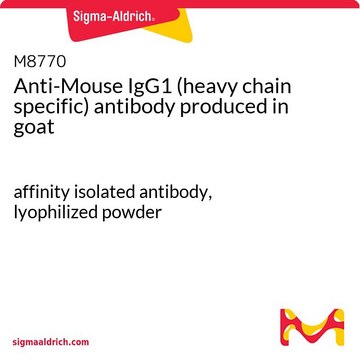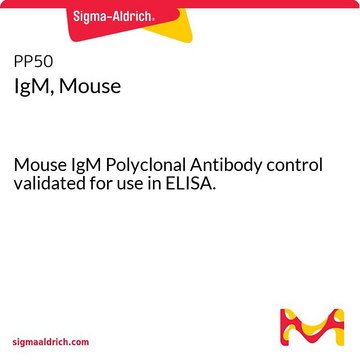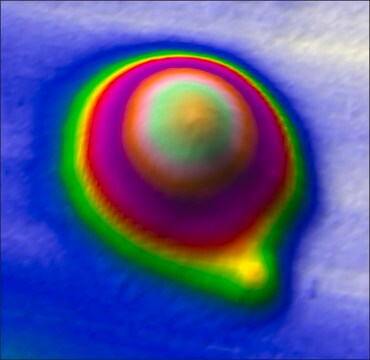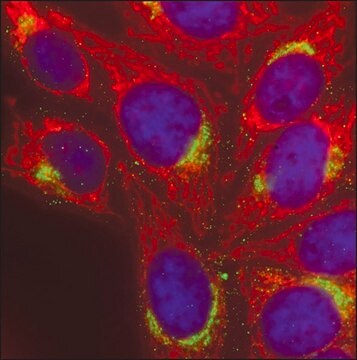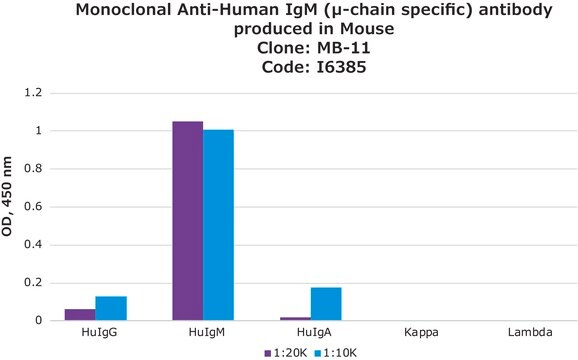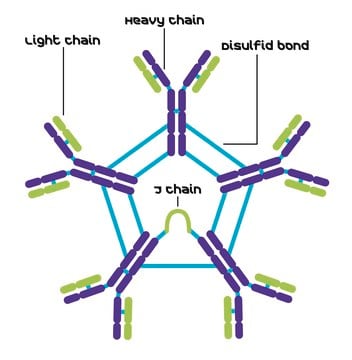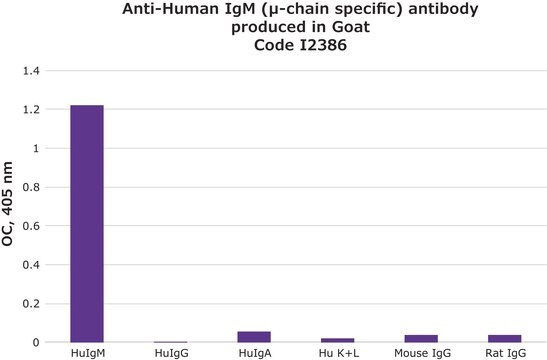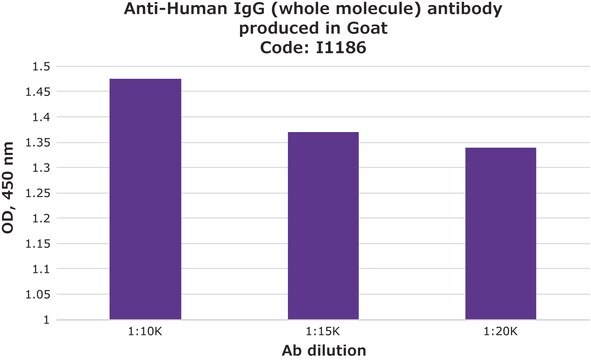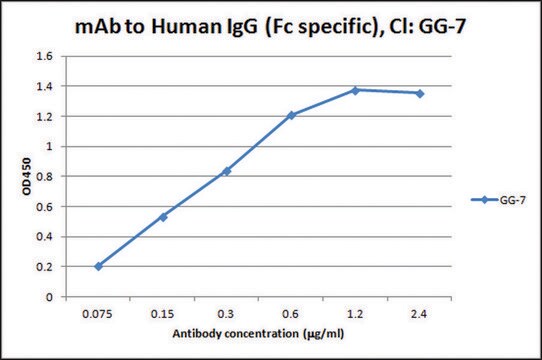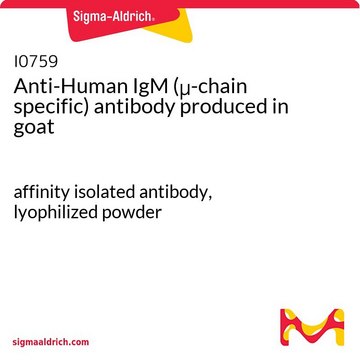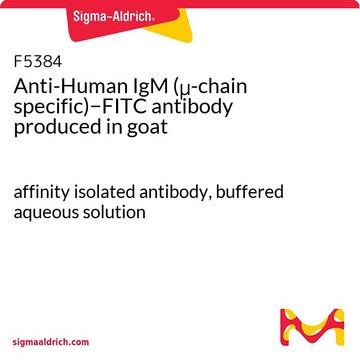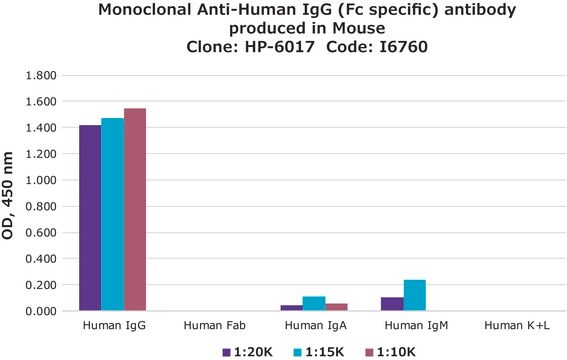SAB4700346
Monoclonal Anti-IgM antibody produced in mouse
clone CH2, purified immunoglobulin, buffered aqueous solution
Sign Into View Organizational & Contract Pricing
All Photos(1)
About This Item
UNSPSC Code:
12352203
NACRES:
NA.46
Recommended Products
biological source
mouse
Quality Level
conjugate
unconjugated
antibody form
purified immunoglobulin
antibody product type
primary antibodies
clone
CH2, monoclonal
form
buffered aqueous solution
species reactivity
human
concentration
1 mg/mL
technique(s)
flow cytometry: suitable
isotype
IgG1
NCBI accession no.
shipped in
wet ice
storage temp.
2-8°C
target post-translational modification
unmodified
Gene Information
human ... IGH@(3492)
Related Categories
General description
Immunoglobulin M (IgM) is a member of immunoglobulin family. It exists as a pentamer in the serum and has a high molecular weight. Monomeric IgM has a molecular weight of 190 kDa. The pentameric IgM is characterized with ten μ heavy chains, ten light chains and a single J-chain which is linked by disulphide bonds. The μ chain consists of five domains- VH, Cμ1, Cμ2, Cμ3 and Cμ4. Limited digestion using papain cleaves the antibody into three fragments, two of which are identical and contain the antigen-binding activity. They are known as fragment antigen binding (Fab) fragments. The third fragment does not possess antigen-binding activity and is known as fragment crystallizable (Fc). It interacts with cells and effector molecules. The heavy chains of IgM contain an extra C domain that replaces the hinge region. IgM is the first antibody to be produced during an immune response and is the major isotype secreted in T-cell independent immune responses.
The antibody CH2 reacts with Fc fragment of human IgM.
Immunogen
Purified human IgM
Application
The reagent is designed for Flow Cytometry analysis. Suggested working dilution for Flow Cytometry is 1 μg/mL of sample. Indicated dilution is recommended starting point for use of this product. Working concentrations should be determined by the investigator.
Features and Benefits
Evaluate our antibodies with complete peace of mind. If the antibody does not perform in your application, we will issue a full credit or replacement antibody. Learn more.
Physical form
Solution in Tris buffered saline, pH 8.0, with 15 mM sodium azide.
Disclaimer
Unless otherwise stated in our catalog or other company documentation accompanying the product(s), our products are intended for research use only and are not to be used for any other purpose, which includes but is not limited to, unauthorized commercial uses, in vitro diagnostic uses, ex vivo or in vivo therapeutic uses or any type of consumption or application to humans or animals.
Not finding the right product?
Try our Product Selector Tool.
Storage Class
10 - Combustible liquids
wgk_germany
WGK 1
flash_point_f
Not applicable
flash_point_c
Not applicable
Choose from one of the most recent versions:
Already Own This Product?
Find documentation for the products that you have recently purchased in the Document Library.
Customers Also Viewed
The structure of a typical antibody molecule
Immunobiology: The Immune System in Health and Disease (2001)
Structural variation in immunoglobulin constant regions
Immunobiology: The Immune System in Health and Disease (2001)
D Martins de Medeiros et al.
Lupus, 23(13), 1412-1416 (2014-06-26)
The objective of this report is to conduct short- and long-term evaluation of a large panel of antiphospholipid (aPL) autoantibodies following pandemic influenza A/H1N1 non-adjuvant vaccine in primary antiphospholipid syndrome (PAPS) patients and healthy controls. Forty-five PAPS and 33 healthy
Andi Krumbholz et al.
Medical microbiology and immunology, 203(4), 273-282 (2014-04-20)
An increase in acute autochthonous hepatitis E virus (HEV) infections has been recorded in Germany. These are suspected to be zoonotically transmitted from wild boar, deer and domestic pig. The latter may represent a major reservoir for HEV. In this
Rosane Oliveira et al.
Journal of medical microbiology, 63(Pt 9), 1119-1130 (2014-06-15)
Leptospirosis, a worldwide zoonotic infection, is an important human and veterinary health problem. We have previously identified a leptospiral multipurpose adhesin, Lsa66, capable of binding extracellular matrix (ECM) components and plasminogen (PLG). In this work, we report the cloning, expression
Our team of scientists has experience in all areas of research including Life Science, Material Science, Chemical Synthesis, Chromatography, Analytical and many others.
Contact Technical Service